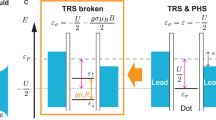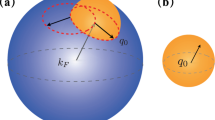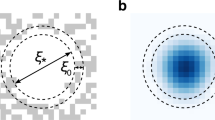Abstract
Interacting quantum many-body systems constitute a fascinating research field because they form quantum liquids with remarkable properties and universal behaviour1. In fermionic systems, such quantum liquids are realized in helium-3 liquid, heavy fermion systems1, neutron stars and cold gases2. Their properties in the linear-response regime have been successfully described by the theory of Fermi liquids1. The idea is that they behave as an ensemble of non-interacting ‘quasi-particles’. However, non-equilibrium properties have still to be established and remain a key issue of many-body physics. Here, we show a precise experimental demonstration of Landau Fermi liquid theory extended to the non-equilibrium regime in a zero-dimensional system. Combining transport and ultra-sensitive current noise measurements, we have unambiguously identified the SU(2) (ref. 3) and SU(4) (refs 4,5,6,7,8) symmetries of a quantum liquid in a carbon nanotube tuned in the universal Kondo regime. Whereas the free quasi-particle picture is found valid around equilibrium9, an enhancement of the current fluctuations is detected out of equilibrium and perfectly explained by an effective charge induced by the residual interaction between quasi-particles8,10,11,12,13,14,15,16,17. Moreover, an as-yet-unknown scaling law for the effective charge is discovered, suggesting a new non-equilibrium universality. Our method paves a new way to explore the exotic nature of quantum liquids out of equilibrium through their fluctuations in a wide variety of physical systems18.
This is a preview of subscription content, access via your institution
Access options
Subscribe to this journal
Receive 12 print issues and online access
$259.00 per year
only $21.58 per issue
Buy this article
- Purchase on SpringerLink
- Instant access to full article PDF
Prices may be subject to local taxes which are calculated during checkout




Similar content being viewed by others
References
Mahan, G. D. Many-Particle Physics (Plenum Press, 1990).
Bloch, I., Dalibard, J. & Nascimbène, S. Quantum simulations with ultracold quantum gases. Nature Phys. 8, 267–276 (2012).
van der Wiel, W. G. et al. The Kondo effect in the unitary limit. Science 289, 2105–2108 (2000).
Jarillo-Herrero, P., Kong, J., Zant, H. S. J. V. D. & Dekker, C. Orbital Kondo effect in carbon nanotubes. Nature 434, 484–488 (2005).
Makarovski, A., Zhukov, A., Liu, J. & Finkelstein, G. SU(2) and SU(4) Kondo effects in carbon nanotube quantum dots. Phys. Rev. B 75, 241407 (2007).
Cleuziou, J. P., NGuyen, N. G., Florens, S. & Wernsdorfer, W. Interplay of the Kondo effect and strong spin–orbit coupling in multihole ultraclean carbon nanotubes. Phys. Rev. Lett. 111, 136803 (2013).
Schmid, D. R. et al. Broken SU(4) symmetry in a Kondo-correlated carbon nanotube. Phys. Rev. B 91, 155435 (2015).
Delattre, T. et al. Noisy Kondo impurities. Nature Phys. 5, 208–212 (2009).
Nozières, P. A “Fermi-Liquid” description of the Kondo problem at low temperatures. J. Low Temp. Phys. 17, 31–42 (1974).
Sela, E., Oreg, Y., von Oppen, F. & Koch, J. Fractional shot noise in the Kondo regime. Phys. Rev. Lett. 97, 086601 (2006).
Oguri, A. Fermi liquid theory for the nonequilibrium Kondo effect at low bias voltages. J. Phys. Soc. Jpn 74, 110–117 (2005).
Gogolin, A. & Komnik, A. Full counting statistics for the Kondo dot in the unitary limit. Phys. Rev. Lett. 97, 016602 (2006).
Mora, C., Leyronas, X. & Regnault, N. Current noise through a Kondo quantum dot in a SU(N) Fermi liquid state. Phys. Rev. Lett. 100, 036604 (2008).
Mora, C., Vitushinsky, P., Leyronas, X., Clerk, A. & Le Hur, K. Theory of nonequilibrium transport in the SU(N) Kondo regime. Phys. Rev. B 80, 155322 (2009).
Sakano, R., Fujii, T. & Oguri, A. Kondo crossover in shot noise of a single quantum dot with orbital degeneracy. Phys. Rev. B 83, 075440 (2011).
Zarchin, O., Zaffalon, M., Heiblum, M., Mahalu, D. & Umansky, V. Two-electron bunching in transport through a quantum dot induced by Kondo correlations. Phys. Rev. B 77, 241303 (2008).
Yamauchi, Y. et al. Evolution of the Kondo effect in a quantum dot probed by shot noise. Phys. Rev. Lett. 106, 176601 (2011).
Egger, R. What the noise is all about. Nature Phys. 5, 175–176 (2009).
Kondo, J. Resistance minimum in dilute magnetic alloys. Prog. Theor. Phys. 32, 37–49 (1964).
Blanter, Y. M. & Büttiker, M. Shot noise in mesoscopic conductors. Phys. Rep. 336, 1–166 (2000).
Kasumov, Y. et al. CVD growth of carbon nanotubes at very low pressure of acetylene. Appl. Phys. A 88, 687–691 (2007).
Arakawa, T., Nishihara, Y., Maeda, M., Norimoto, S. & Kobayashi, K. Cryogenic amplifier for shot noise measurement at 20 mK. Appl. Phys. Lett. 103, 172104 (2013).
Sakano, R., Oguri, A., Kato, T. & Tarucha, S. Full counting statistics for SU(N) impurity Anderson model. Phys. Rev. B 83, 241301 (2011).
Galpin, M. R., Logan, D. E. & Krishnamurthy, H. R. Quantum phase transition in capacitively coupled double quantum dots. Phys. Rev. Lett. 94, 186406 (2005).
Acknowledgements
We appreciate discussions with H. Bouchiat and R. Yoshii. This work was partially supported by a Grant-in-Aid for Scientific Research (S) (No. 26220711), JSPS KAKENHI (No. 26400319, 25800174 and 15K17680), Invitation Fellowships for Research in Japan from JSPS, Grant-in-Aid for Scientific Research on Innovative Areas ‘Fluctuation & Structure’ (No. 25103003) and ‘Topological Materials Science’ (KAKENHI Grant No. 15H05854), the Program for Promoting the Enhancement of Research Universities from MEXT, and Yazaki Memorial Foundation for Science and Technology, and the French programmes ANR DYMESYS (ANR2011-IS04-001-01) and ANR MASH (ANR-12-BS04-0016). K.K. acknowledges the stimulating discussions in the meeting of the Cooperative Research Project of RIEC, Tohoku University.
Author information
Authors and Affiliations
Contributions
All the authors contributed to the analysis of the data and commented on the manuscript. M.F., R. Delagrange., R.W. and R. Deblock designed the sample. M.F., T.A., T.H. and R.F. performed the noise experiments and analysed the data. M.F. and K.K. planned and supervised the research.
Corresponding authors
Ethics declarations
Competing interests
The authors declare no competing financial interests.
Supplementary information
Supplementary information
Supplementary information (PDF 1133 kb)
Rights and permissions
About this article
Cite this article
Ferrier, M., Arakawa, T., Hata, T. et al. Universality of non-equilibrium fluctuations in strongly correlated quantum liquids. Nature Phys 12, 230–235 (2016). https://doi.org/10.1038/nphys3556
Received:
Accepted:
Published:
Issue date:
DOI: https://doi.org/10.1038/nphys3556
This article is cited by
-
Three-body correlations in nonlinear response of correlated quantum liquid
Nature Communications (2021)
-
Quantum Noise in Carbon Nanotubes as a Probe of Correlations in the Kondo Regime
Journal of Low Temperature Physics (2020)
-
Electronic and Optical Properties of Single Wall Carbon Nanotubes
Topics in Current Chemistry (2017)
-
Blocking transport resonances via Kondo many-body entanglement in quantum dots
Nature Communications (2016)



